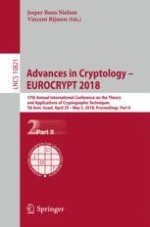2018 | OriginalPaper | Buchkapitel
But Why Does It Work? A Rational Protocol Design Treatment of Bitcoin
verfasst von : Christian Badertscher, Juan Garay, Ueli Maurer, Daniel Tschudi, Vassilis Zikas
Erschienen in: Advances in Cryptology – EUROCRYPT 2018
Aktivieren Sie unsere intelligente Suche, um passende Fachinhalte oder Patente zu finden.
Wählen Sie Textabschnitte aus um mit Künstlicher Intelligenz passenden Patente zu finden. powered by
Markieren Sie Textabschnitte, um KI-gestützt weitere passende Inhalte zu finden. powered by
